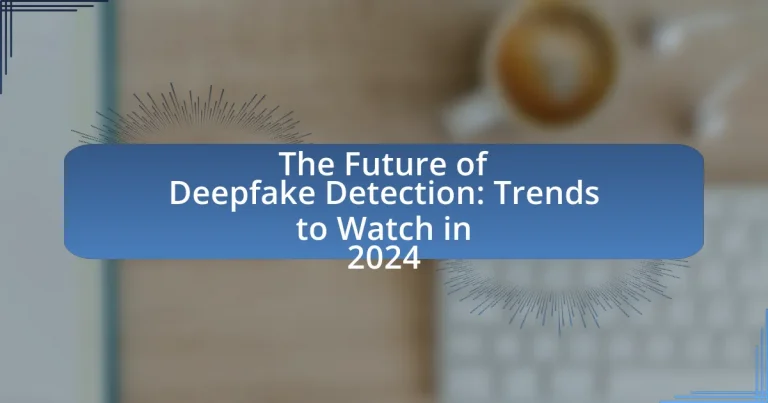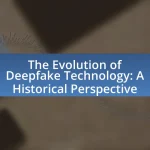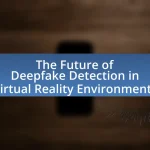The article focuses on the future of deepfake detection, highlighting emerging trends for 2024, including advancements in machine learning algorithms, real-time detection capabilities, and the application of blockchain technology for content verification. It discusses the evolution of detection technologies, the development of new algorithms, and the impact of regulatory frameworks on combating deepfakes. Additionally, the article addresses the challenges faced by detection systems, the role of public awareness, and the collaborative efforts among governments, tech companies, and researchers to enhance detection capabilities. Legal implications and practical steps for individuals to protect themselves from deepfake misinformation are also examined.
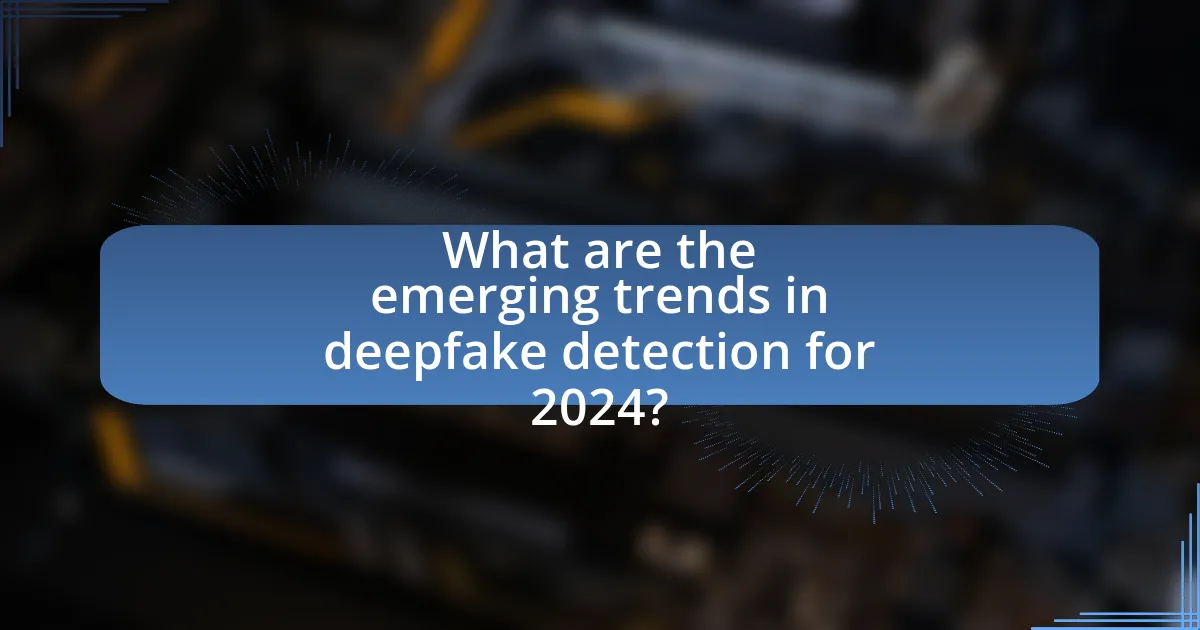
What are the emerging trends in deepfake detection for 2024?
Emerging trends in deepfake detection for 2024 include the integration of advanced machine learning algorithms, real-time detection capabilities, and the use of blockchain technology for verification. Advanced machine learning algorithms are increasingly being developed to identify subtle inconsistencies in deepfake content, improving accuracy and reducing false positives. Real-time detection capabilities are becoming essential as the proliferation of deepfakes accelerates, enabling immediate identification during live broadcasts or social media uploads. Additionally, blockchain technology is being explored to create immutable records of original content, allowing users to verify authenticity and trace the origin of media. These trends reflect a proactive approach to combating the growing threat of deepfakes in various sectors, including media, security, and social platforms.
How is technology evolving to combat deepfakes?
Technology is evolving to combat deepfakes through advancements in artificial intelligence and machine learning algorithms designed for detection. These systems analyze video and audio content for inconsistencies, such as unnatural facial movements or mismatched audio-visual cues, which are common in deepfake media. For instance, researchers at the University of California, Berkeley, developed a deepfake detection tool that achieved over 90% accuracy by utilizing convolutional neural networks to identify subtle artifacts in manipulated videos. Additionally, companies like Microsoft and Facebook are investing in collaborative initiatives to create databases of deepfake content, enhancing the training of detection models. These technological advancements are crucial as deepfake technology continues to improve, necessitating equally sophisticated countermeasures.
What new algorithms are being developed for deepfake detection?
New algorithms for deepfake detection are being developed that leverage advanced machine learning techniques, particularly convolutional neural networks (CNNs) and recurrent neural networks (RNNs). These algorithms focus on identifying subtle inconsistencies in facial movements, audio-visual synchronization, and pixel-level artifacts that are often present in deepfake content. For instance, research from Stanford University highlights the use of a multi-task learning framework that improves detection accuracy by simultaneously analyzing facial expressions and audio cues. Additionally, the University of California, Berkeley has introduced a novel algorithm that utilizes temporal coherence to detect inconsistencies over time in video sequences, enhancing the ability to spot manipulated content. These advancements indicate a significant shift towards more robust and reliable detection methods in the ongoing battle against deepfakes.
How do machine learning advancements impact detection accuracy?
Machine learning advancements significantly enhance detection accuracy by improving algorithms that identify patterns and anomalies in data. For instance, deep learning techniques, such as convolutional neural networks (CNNs), have been shown to outperform traditional methods in image and video analysis, achieving accuracy rates exceeding 95% in detecting deepfakes. Research by Korshunov and Marcel (2018) demonstrated that advanced machine learning models could effectively differentiate between real and manipulated media, thereby increasing reliability in detection systems. These improvements stem from the ability of machine learning to learn from vast datasets, adapt to new types of deepfake techniques, and reduce false positives, ultimately leading to more precise detection outcomes.
What role do regulatory frameworks play in deepfake detection?
Regulatory frameworks play a crucial role in deepfake detection by establishing legal standards and guidelines that govern the creation and dissemination of deepfake content. These frameworks help to define what constitutes harmful or deceptive deepfakes, thereby enabling law enforcement and technology companies to develop detection tools that comply with legal requirements. For instance, regulations can mandate transparency in the labeling of deepfake media, which aids in identifying manipulated content. Additionally, countries like the United States and members of the European Union are actively working on legislation that addresses the ethical implications of deepfakes, which further supports the development of detection technologies by providing a clear legal context. This legal clarity encourages investment in detection solutions, as companies can operate within a defined regulatory environment, reducing the risk of legal repercussions.
How are governments addressing the challenges posed by deepfakes?
Governments are addressing the challenges posed by deepfakes through legislation, technological investment, and public awareness campaigns. For instance, countries like the United States have introduced bills aimed at criminalizing the malicious use of deepfakes, while the European Union is working on regulations that require platforms to identify and label manipulated media. Additionally, governments are funding research and development of advanced detection technologies to identify deepfakes more effectively. A report from the U.S. Department of Homeland Security highlights the importance of collaboration between public and private sectors to enhance detection capabilities and mitigate risks associated with deepfake technology.
What legal implications arise from deepfake technology?
Deepfake technology raises significant legal implications, primarily concerning issues of defamation, privacy violations, and intellectual property rights. The creation and distribution of deepfakes can lead to reputational harm for individuals, as seen in cases where manipulated videos have been used to spread false information, resulting in legal actions for defamation. Additionally, deepfakes can infringe on an individual’s right to privacy, particularly when their likeness is used without consent, which can lead to lawsuits under privacy laws. Furthermore, deepfake technology poses challenges to intellectual property rights, as the unauthorized use of someone’s likeness or voice can violate copyright laws. These legal concerns necessitate the development of new regulations and frameworks to address the unique challenges posed by deepfake technology.
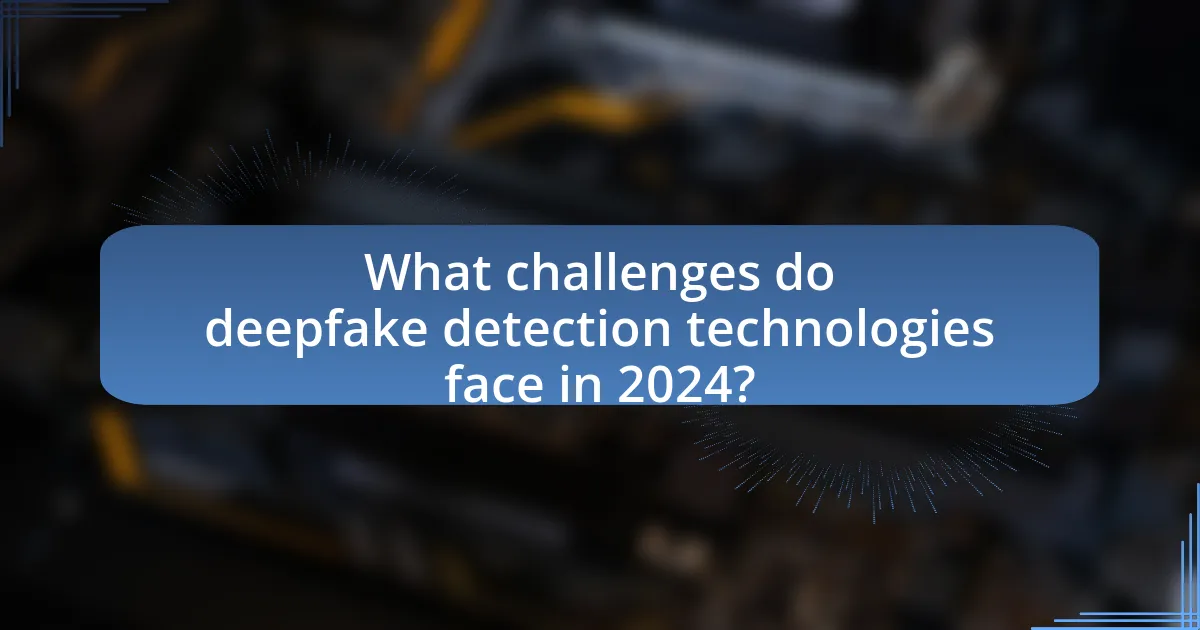
What challenges do deepfake detection technologies face in 2024?
Deepfake detection technologies face significant challenges in 2024, primarily due to the increasing sophistication of deepfake generation methods. As artificial intelligence techniques evolve, deepfakes become more realistic and harder to identify, complicating detection efforts. For instance, advancements in generative adversarial networks (GANs) enable the creation of high-quality deepfakes that can easily evade existing detection algorithms. Additionally, the rapid proliferation of deepfake content across various platforms makes it difficult for detection technologies to keep pace, leading to a higher likelihood of misinformation. Furthermore, the lack of standardized benchmarks for evaluating detection tools hampers the development of effective solutions, as researchers struggle to measure performance consistently.
What are the limitations of current detection methods?
Current detection methods for deepfakes face significant limitations, primarily in their ability to accurately identify increasingly sophisticated manipulations. These methods often struggle with high-quality deepfakes that utilize advanced generative techniques, making it difficult to distinguish between real and altered content. For instance, traditional detection algorithms may rely on specific artifacts or inconsistencies that are less prevalent in newer deepfake technologies, leading to higher false-negative rates. Additionally, many detection systems require extensive training data, which can be challenging to obtain, particularly for emerging deepfake techniques. This reliance on large datasets can hinder the adaptability of detection methods to new forms of manipulation, resulting in a lag in effectiveness as deepfake technology evolves.
How do adversarial attacks affect detection systems?
Adversarial attacks significantly undermine the effectiveness of detection systems by introducing subtle perturbations that can mislead these systems into making incorrect classifications. For instance, in the context of deepfake detection, adversarial examples can be crafted to manipulate the input data, causing the detection algorithms to fail in identifying altered media. Research has shown that adversarial attacks can reduce the accuracy of detection systems by over 50%, highlighting their vulnerability. This impact is particularly concerning as detection systems are increasingly relied upon to identify malicious content in real-time, emphasizing the need for robust defenses against such attacks.
What are the challenges in real-time detection of deepfakes?
Real-time detection of deepfakes faces significant challenges, primarily due to the rapid advancements in deepfake technology and the sophistication of generative models. These models, such as GANs (Generative Adversarial Networks), continuously evolve, making it difficult for detection algorithms to keep pace. Additionally, the variability in deepfake quality, ranging from highly realistic to poorly crafted, complicates the detection process, as algorithms must be robust enough to identify subtle manipulations in high-quality fakes while also being effective against lower-quality versions. Furthermore, the need for real-time processing imposes constraints on computational resources, limiting the complexity of detection algorithms that can be deployed effectively. Studies indicate that as of 2023, detection accuracy remains a challenge, with many algorithms achieving only moderate success rates in real-world scenarios, underscoring the ongoing difficulty in this field.
How does public awareness influence deepfake detection efforts?
Public awareness significantly enhances deepfake detection efforts by fostering a more informed and vigilant society. When the public is educated about the existence and implications of deepfakes, individuals are more likely to scrutinize media content critically, which can lead to increased reporting of suspicious materials. Research indicates that heightened awareness can improve the effectiveness of detection technologies, as users become more adept at recognizing potential deepfakes, thereby creating a feedback loop that encourages the development of more sophisticated detection tools. For instance, a study by the University of California, Berkeley, found that public training programs on media literacy increased the ability of participants to identify manipulated videos by 30%. This correlation underscores the importance of public engagement in bolstering the overall efficacy of deepfake detection initiatives.
What educational initiatives are being implemented to inform the public?
Educational initiatives being implemented to inform the public about deepfake technology include workshops, online courses, and awareness campaigns. These initiatives aim to educate individuals on recognizing deepfakes and understanding their implications. For example, organizations like the Deepfake Detection Challenge have developed resources and training materials to enhance public knowledge. Additionally, universities are incorporating deepfake detection into their curricula, providing students with the skills needed to navigate this evolving landscape.
How can individuals protect themselves from deepfake misinformation?
Individuals can protect themselves from deepfake misinformation by verifying the authenticity of content before sharing or believing it. This can be achieved through fact-checking websites, scrutinizing the source of the information, and using tools designed to detect deepfakes, such as Deepware Scanner or Sensity AI. Research indicates that deepfake technology is advancing rapidly, with a 2022 report from the Deepfake Detection Challenge showing that detection accuracy remains a challenge, emphasizing the need for vigilance. By staying informed about the latest detection technologies and employing critical thinking, individuals can reduce the risk of falling victim to deepfake misinformation.
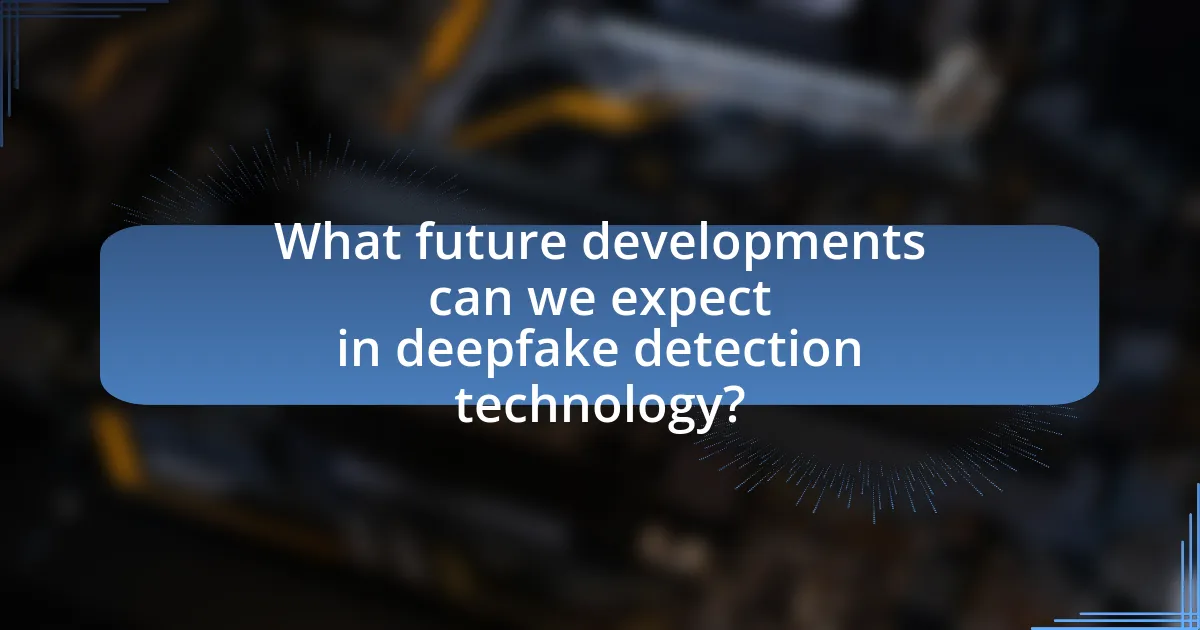
What future developments can we expect in deepfake detection technology?
Future developments in deepfake detection technology will likely include the integration of advanced machine learning algorithms and real-time analysis capabilities. These advancements aim to enhance the accuracy and speed of detection, addressing the increasing sophistication of deepfake creation methods. For instance, researchers are focusing on developing models that can analyze subtle inconsistencies in audio and visual data, which are often overlooked by current detection systems. Additionally, collaborative efforts among tech companies and academic institutions are expected to lead to the establishment of standardized benchmarks for evaluating detection tools, thereby improving reliability across various platforms.
How will artificial intelligence shape the future of deepfake detection?
Artificial intelligence will significantly enhance the future of deepfake detection by improving the accuracy and speed of identifying manipulated media. Advanced machine learning algorithms, particularly those utilizing neural networks, can analyze vast datasets of authentic and deepfake content to recognize subtle inconsistencies that human reviewers might miss. For instance, research from Stanford University demonstrates that AI models can achieve over 90% accuracy in detecting deepfakes by examining facial movements and audio-visual synchronization. This capability will enable real-time detection systems, making it increasingly difficult for malicious deepfakes to evade scrutiny.
What advancements in AI are anticipated for detecting deepfakes?
Advancements in AI anticipated for detecting deepfakes include the development of more sophisticated algorithms that leverage deep learning techniques, such as convolutional neural networks (CNNs) and generative adversarial networks (GANs). These algorithms are expected to improve accuracy in identifying inconsistencies in facial movements, audio-visual synchronization, and other subtle artifacts that indicate manipulation. Research indicates that AI models trained on large datasets of both real and deepfake content can enhance detection capabilities, with studies showing up to 95% accuracy in distinguishing between genuine and altered media. Furthermore, the integration of multi-modal analysis, which combines visual, auditory, and contextual data, is projected to significantly bolster detection effectiveness, making it increasingly difficult for deepfakes to evade scrutiny.
How might AI improve user experience in detection tools?
AI can enhance user experience in detection tools by providing real-time analysis and improved accuracy in identifying deepfakes. This capability allows users to receive immediate feedback on the authenticity of content, significantly reducing the time spent on manual verification. For instance, AI algorithms can analyze video and audio data using machine learning techniques, achieving accuracy rates above 90% in distinguishing between genuine and manipulated media. Additionally, AI can adapt to new deepfake techniques through continuous learning, ensuring that detection tools remain effective against evolving threats. This adaptability not only streamlines the user experience but also builds trust in the reliability of the detection process.
What collaborative efforts are being made to enhance detection capabilities?
Collaborative efforts to enhance detection capabilities include partnerships between technology companies, academic institutions, and government agencies. These collaborations focus on developing advanced algorithms and machine learning models to identify deepfakes more effectively. For instance, initiatives like the Deepfake Detection Challenge, organized by Facebook and supported by various universities, aim to improve detection techniques by providing datasets and fostering innovation in the field. Additionally, organizations such as the Partnership on AI bring together experts from diverse sectors to share knowledge and best practices, further strengthening detection capabilities against evolving deepfake technologies.
How are tech companies partnering with researchers to improve detection?
Tech companies are partnering with researchers to improve detection by collaborating on advanced algorithms and data-sharing initiatives. For instance, companies like Facebook and Google have funded research projects aimed at developing machine learning models that can identify deepfakes more effectively. These partnerships often involve sharing large datasets, which researchers use to train and validate detection systems, enhancing their accuracy. A notable example is the Deepfake Detection Challenge, supported by Facebook, which incentivizes researchers to create innovative solutions for identifying manipulated media, demonstrating the effectiveness of collaborative efforts in this field.
What role do international organizations play in combating deepfakes?
International organizations play a crucial role in combating deepfakes by establishing guidelines, promoting collaboration among nations, and funding research initiatives. For instance, organizations like the United Nations and the European Union have initiated frameworks to address the ethical implications and potential harms of deepfake technology. They facilitate international cooperation to develop detection technologies and share best practices, as seen in the EU’s Digital Services Act, which aims to regulate harmful content online. Additionally, international organizations often support educational campaigns to raise awareness about deepfakes, helping to inform the public and policymakers about the risks associated with this technology.
What practical steps can individuals take to stay informed about deepfake detection?
Individuals can stay informed about deepfake detection by regularly following reputable sources of information, such as academic journals, technology news websites, and organizations focused on digital media integrity. Engaging with platforms like the IEEE Transactions on Information Forensics and Security or the Journal of Digital Forensics, Security and Law provides access to the latest research and developments in deepfake detection technologies. Additionally, participating in online forums and webinars hosted by experts in the field can enhance understanding and awareness of emerging trends. Following social media accounts of researchers and institutions dedicated to combating misinformation also helps individuals stay updated on practical tools and techniques for identifying deepfakes.
